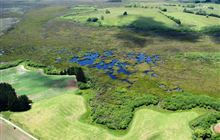Australasian bittern/matuku-hūrepo
Introduction
The endangered matuku-hūrepo inhabits wetlands throughout New Zealand. DOC is focusing on developing methods for surveying bittern systematically and for restoring wetlands.New Zealand status: Native
Conservation status: Threatened–Nationally Critical
Population: Less than 1,000 in New Zealand
Found in: Wetlands in New Zealand, Australia, New Caledonia
Threats: Habitat loss, predation, disturbance
Sound recordings:
Australasian bittern/matuku-hūrepo territorial call (MP3, 1,886K)
02:00 – Booming call.
Our bird songs can be reused, even commercially, according to our copyright terms.
Species information: Australasian bittern/matuku-hūrepo on NZ Birds Online
Australasian bittern conservation
Emergency hotline
Call 0800 DOC HOT (0800 362 468) immediately if you see anyone catching, harming or killing native wildlife.
Globally endangered
Matuku-hūrepo are important to Māori. They appear in language as part of legends, stories, early pictures and metaphor and there are numerous place names referring to them. They were important for food and their feathers were used for ceremonial decoration.
When Europeans arrived they were abundant, but now it is rare to see more than one at a time. Australasian bittern are also found in Australia and New Caledonia, but populations there have declined dramatically and they are now classed globally as endangered.
Dependence on wetlands
In New Zealand, they are mainly found in wetlands of Northland, Waikato, East Coast of the North Island, and the West Coast of the South Island. The most important site nationally for matuku-hūrepo is Whangamarino Wetland in the Waikato.
Matuku-hūrepo are a potential indicator of wetland health because they are dependent on the presence of high quality and ecologically diverse habitats and rich food supplies.
Management tools
Although wetlands support a range of threatened species, management techniques for restoring populations are poorly developed.
We are focusing on developing methods for surveying and monitoring bittern systematically. These methods will establish baseline data and distribution maps; identify important wetland habitat types for conservation; measure the response of matuku-hūrepo to management such as pest control, habitat maintenance and restoration.
DOC has been developing ‘call counts’ for bittern. These take place with either an observer listening for set times at dawn or dusk for the booming calls of bittern, or with new automatic recorders (electronic recorders developed by the DOC Electronics Lab) recording calls remotely.
We are also developing methods for restoring wetlands through the Arawai Kākāriki programme. Restoration involves developing management tools including methods for controlling weeds and predators, managing water levels water quality, and restoring wetland vegetation and food supplies for bitterns.


